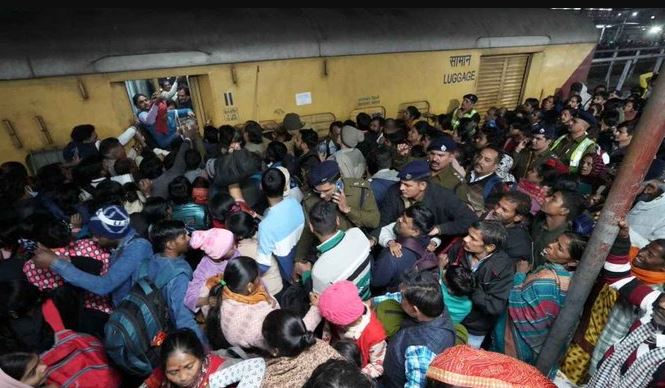The Prayagraj Maha Kumbh Mela 2025, one of the largest religious gatherings in the world, has been marred by a series of tragic incidents that have exposed deep flaws in crowd management, infrastructure planning, and administrative oversight. From a deadly stampede at the Sangam Ghat in Prayagraj to a subsequent disaster at New Delhi Railway Station, these events have resulted in significant loss of life and injuries, raising serious concerns about public safety.
The incidents, occurring amidst millions of devotees gathered for this spiritually significant event, have drawn widespread criticism from opposition leaders, pilgrims, and experts alike.
Also Read: Maha Kumbh 2025 Footfall Crosses 50 Crore, Surpassing US and Russia’s Combined Population
Allegations of mismanagement, inadequate preparations, and a focus on VIP culture over the safety of common citizens have dominated discussions, with many questioning the government’s ability to handle such massive gatherings effectively. Below is a detailed analysis of the key incidents, their causes, and the broader implications, based on available information.
Also Read: Fatal Stampedes in India Over the Years: What Went Wrong?
- Stampede at Prayagraj Maha Kumbh Mela
Date and Location: On January 29, 2025, a deadly stampede occurred at the Sangam Ghat in Prayagraj, Uttar Pradesh, during the Maha Kumbh Mela, specifically on the auspicious day of Mauni Amavasya.
Casualties: Reports indicate at least 30 people were killed, with 60 others injured. However, some sources suggest the death toll could be higher, with discrepancies in official figures leading to criticism.
Cause: The stampede was triggered by a combination of factors:
Barrier Collapse: A barrier broke at the Sangam Nose, leading to a chaotic rush of pilgrims attempting to take a holy dip. - Overcrowding: Millions of devotees had gathered, with estimates suggesting up to 10 crore (100 million) pilgrims were present on that day, overwhelming the infrastructure.
VIP Culture: Eyewitnesses and opposition leaders have pointed to mismanagement due to prioritizing VIP movements. Many pontoon bridges were reportedly closed to accommodate VIPs, causing bottlenecks and restricting access for common devotees.
Poor Crowd Control: Despite claims of advanced preparations, including AI-driven systems and aquatic surveillance, the crowd control measures failed to manage the massive influx of pilgrims effectively.
Response:
The Uttar Pradesh government initially downplayed the incident but later ordered a judicial probe after public outcry. A three-member judicial commission was established to investigate and submit a report within a month.
Measures post-incident included declaring the Mela area a no-vehicle zone, canceling VVIP passes, and imposing a ban on four-wheelers in Prayagraj until February 4, 2025.
Criticism: Opposition leaders, including Rahul Gandhi and Mallikarjun Kharge, blamed the state government for “half-baked arrangements” and prioritizing self-promotion over safety. Eyewitnesses reported inadequate police presence and delayed response, exacerbating the tragedy. - Stampede at New Delhi Railway Station
Date and Location: On February 15, 2025, a stampede occurred at New Delhi Railway Station, as pilgrims attempted to board trains to Prayagraj for the ongoing Maha Kumbh Mela.
Casualties: At least 18 people were killed, including nine women, five children, and four men, with over a dozen injured. The victims included vulnerable groups such as minors and the elderly.
Cause: The incident was attributed to several factors:
Platform Change Confusion: Preliminary reports suggest that a sudden announcement of a platform change for a Prayagraj-bound special train caused confusion and a rush among passengers on platforms 14 and 15.
Overcrowding: The station saw a massive influx of passengers, exacerbated by the cancellation or delay of two trains, leading to a swell of crowds waiting to board.
Mismanagement: There were allegations of inadequate crowd control measures, poor communication about train schedules, and insufficient security presence. Reports indicate that 1,500 general tickets were sold per hour, contributing to the overcrowding.
Lack of Preparedness: Despite the anticipated rush due to the Maha Kumbh, the railway authorities failed to implement effective measures to manage the crowd, such as additional trains or better scheduling announcements.
Response:
A two-member committee, comprising Narsingh Deo (PCCM, Northern Railway) and Pankaj Gangwar (PCSC, Northern Railway), was formed to investigate the incident. The committee began examining CCTV footage and collecting witness statements.
Compensation was announced: ₹10 lakh for the families of the deceased, ₹2.5 lakh for the seriously injured, and ₹1 lakh for those with minor injuries.
Prime Minister Narendra Modi and Railway Minister Ashwini Vaishnaw expressed condolences and assured assistance to the affected.
Criticism: Opposition leaders, including Rahul Gandhi and Atishi, accused the central and Uttar Pradesh governments of negligence and insensitivity. There were calls for the Railway Minister’s resignation, with critics highlighting a pattern of railway accidents and poor infrastructure management. - Common Themes of Mismanagement
Inadequate Planning: Both incidents reflect a failure to anticipate and manage the massive crowds expected during the Maha Kumbh Mela. Despite significant budgets (₹7,500 crore for the Mela) and claims of advanced preparations, the infrastructure and crowd control measures were insufficient.
VIP Prioritization: In Prayagraj, the closure of routes and bridges for VIPs restricted access for common pilgrims, contributing to the stampede. This “VIP culture” was widely criticized as a root cause of the tragedy.
Poor Communication: At New Delhi Railway Station, the sudden change in platform announcements without clear communication led to chaos. Similarly, in Prayagraj, devotees reported a lack of guidance and information from authorities.
Delayed Response: In both cases, the response from authorities was criticized as slow and inadequate. In Prayagraj, rescue operations were hampered by the lack of immediate medical support, while in Delhi, police and emergency services arrived late.
Lack of Accountability: Initial attempts by officials to downplay the incidents (e.g., dismissing stampede reports as rumors) and discrepancies in death toll figures have fueled public anger and demands for transparency. - Broader Implications
Recurring Issue: The Maha Kumbh Mela has a history of stampedes, with notable incidents in 1954 (800 deaths), 1986 (200 deaths), 2003 (39 deaths), and 2013 (36 deaths). The 2025 incidents highlight a persistent failure to learn from past tragedies and implement effective safety measures.
Public Trust: The mishandling of these events has eroded public trust in the administration, with many questioning the government’s ability to manage large-scale religious gatherings.
Calls for Reform: There have been calls for systemic changes, including better crowd management training, increased use of technology for real-time monitoring, regulation of VIP movements, and accountability for officials responsible for lapses.
The stampedes at Prayagraj and New Delhi Railway Station during the Maha Kumbh Mela 2025 underscore significant mismanagement and systemic failures in planning, crowd control, and emergency response. While the Uttar Pradesh government and Indian Railways have initiated investigations and announced measures to prevent future incidents, the tragedies have exposed deep-rooted issues in managing large-scale events in India. Addressing these challenges will require a comprehensive overhaul of safety protocols, improved coordination between agencies, and a shift away from prioritizing VIPs over the safety of common citizens.



